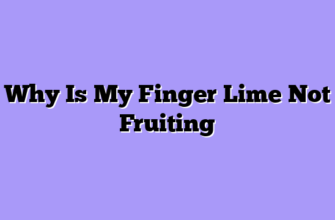Let me paint you a picture. You’re standing in a misty Australian rainforest, dappled sunlight filtering through towering eucalyptus trees, and tucked beneath the canopy are these remarkable thorny shrubs laden with elongated, jewel-toned fruits. This is where finger limes – or Citrus australasica as the botanists call them – evolved to thrive. Understanding this native habitat is your golden ticket to successfully growing these caviar limes anywhere in the world.
I’ve spent countless hours experimenting with different locations, microclimates, and growing conditions for these finicky Australian natives. And here’s what I’ve learned: finger limes are basically the divas of the citrus world. They have very specific preferences, and when you honor those preferences, they reward you with incredible growth and those amazing caviar-like pearls that make chefs go weak in the knees.
The secret isn’t just about climate zones or temperature ranges – though those matter tremendously. It’s about understanding that these bush limes, lime pearls, or native finger limes (whatever you prefer to call them) are telling us exactly what they need through their natural habitat. Think of it like being a detective, piecing together clues about where these remarkable citrus caviar producers will be happiest in your specific corner of the world.
Climate Zones: The Foundation of Success
Here’s something that might surprise you – finger limes are actually more cold-tolerant than most people realize. While they’re native to the subtropical coastal regions of Australia, I’ve successfully grown them in areas that drop to the mid-20s Fahrenheit for brief periods. The key word here is “brief.” These plants can handle a light frost, but prolonged freezing temperatures will shut them down faster than you can say “caviar citrus.”

The magic happens when you can provide what I call the “Goldilocks conditions” – not too hot, not too cold, but just right. These native Australian limes prefer temperatures between 60-85°F for optimal growth. When temperatures consistently exceed 90°F, especially with low humidity, they tend to slow down or even stop growing entirely.
| Climate Zone | Temperature Range | Growing Success | Special Considerations |
|---|---|---|---|
| USDA 8b | 15-20°F minimum | Marginal | Requires protection, container growing |
| USDA 9a-9b | 20-30°F minimum | Good | Some winter protection helpful |
| USDA 10a-10b | 30-40°F minimum | Excellent | Ideal outdoor growing conditions |
| USDA 11 | 40°F+ minimum | Variable | May need summer shade, humidity management |
What’s fascinating about these lime pearls is their humidity requirements. Coming from coastal rainforest environments, they absolutely love humidity levels between 50-70%. This is where many growers in arid climates struggle – you can have the perfect temperature range, but if your air is bone dry, your finger limes will never reach their full potential.
Microclimates: Creating Your Own Finger Lime Paradise
Now, here’s where the real magic happens in growing these bush limes successfully. You don’t need to live in Australia to create the perfect growing environment – you just need to understand how to manipulate your local microclimate. I’ve created thriving finger lime groves in locations that theoretically shouldn’t work, simply by paying attention to the subtle environmental factors that make all the difference.
The most successful finger lime installations I’ve seen share certain characteristics, regardless of their geographic location. They’re typically situated where they receive morning sun but are protected from the harsh afternoon heat. These caviar citrus plants evolved in forest understories, remember? They’re used to filtered light, not blazing desert sun.
Key Microclimate Factors for Optimal Growth:
- Morning sun exposure (4-6 hours of direct sunlight)
- Afternoon shade or filtered light
- Protection from strong, drying winds
- Consistent soil moisture without waterlogging
- Good air circulation to prevent fungal issues
- Slightly elevated planting to ensure drainage
- Nearby structures or plants that moderate temperature extremes
I’ve discovered that proximity to large bodies of water can be incredibly beneficial for growing these native finger limes. The thermal mass of water moderates temperature swings and naturally increases humidity levels. Some of my most productive specimens are planted within a few hundred yards of ponds or streams.
Wind protection is absolutely crucial, and this is where many people go wrong. These plants evolved in sheltered forest environments, and constant wind exposure stresses them tremendously. I’ve seen finger limes planted in windy locations struggle for months, then explode with growth once I installed windbreaks or moved them to more protected spots.
Regional Variations: Adapting to Your Local Conditions
Let me share some insights from my experiments across different regions, because what works in Florida definitely doesn’t work in California, and neither approach is right for Texas. Each region presents unique challenges and opportunities for growing these remarkable caviar limes.
Pacific Coast regions offer some of the most naturally suitable conditions for Citrus australasica. The marine influence moderates temperatures and provides the humidity these plants crave. However, the key is finding locations protected from salt spray and strong ocean winds. I’ve had excellent success in areas 5-10 miles inland from the coast, where you get the marine climate benefits without the harsh salt exposure.
Southeastern United States presents a different set of opportunities and challenges. The humidity is perfect, and summer temperatures are generally within the acceptable range. The challenge comes with winter protection and managing the intense summer heat. Strategic placement under high pine canopies or deciduous trees works wonderfully – you get winter sun when the leaves are down and summer shade when protection is needed most.
Desert Southwest might seem impossible for these rainforest natives, but I’ve seen some creative solutions work beautifully. The secret is creating artificial microclimates through strategic use of shade cloth, misting systems, and thermal mass. Container growing becomes essential here, allowing you to move plants to optimal locations seasonally.
- Choose locations with natural wind protection (near buildings, fences, or larger plants)
- Install shade cloth in areas with intense summer sun (30-50% shade cloth works well)
- Create humidity zones using mulch, companion plantings, or water features
- Consider elevation changes in your property for drainage and cold air flow
- Test soil drainage thoroughly before committing to permanent plantings
- Plan for seasonal protection if you’re in marginal climate zones
| Region | Best Planting Zones | Primary Challenges | Success Strategies |
|---|---|---|---|
| Pacific Coast | Zones 9-10, inland areas | Salt exposure, wind | Windbreaks, inland placement |
| Southeast US | Zones 8b-10a | Summer heat, winter cold | High shade, thermal protection |
| Desert Southwest | Zones 9-11 (containers) | Low humidity, extreme heat | Artificial microclimates, containers |
| Gulf Coast | Zones 9-10 | Hurricane damage, soil salinity | Storm protection, raised beds |
Container Growing: The Ultimate Flexibility Solution
Here’s something I wish someone had told me when I first started growing these lime pearls – containers might actually be the best way to grow finger limes in many situations. This isn’t giving up or taking the easy way out; it’s strategic gardening that allows you to provide optimal conditions regardless of your natural climate.
Container growing gives you godlike powers over your finger lime’s environment. Too hot? Move it to shade. Too cold? Bring it to a protected area. Soil not quite right? You control every aspect of the growing medium. It’s like having a remote control for your plant’s happiness.
The key to successful container cultivation of these bush limes is choosing appropriately sized containers and understanding their specific needs. I use containers that are at least 20-25 gallons for mature plants, with excellent drainage holes and high-quality potting mix designed for citrus.

The mobility factor cannot be overstated. Weather forecast calling for an unexpected freeze? Roll that container to safety. Brutal heat wave incoming? Slide it into temporary shade. It’s like having insurance for your investment in these relatively expensive and slow-growing native Australian citrus.
What really excites me about container growing is how it opens up finger lime cultivation to people in challenging climates. I’ve helped growers in Minnesota and Alberta successfully cultivate these caviar citrus plants by bringing them indoors during harsh winters and maximizing their outdoor growing season.
The bottom line is this: finger limes grow best where you can replicate their native rainforest conditions – dappled light, consistent moisture, protection from extremes, and that magical combination of warmth and humidity that makes them feel at home. Whether that’s in your backyard in San Diego, under a shade structure in Phoenix, or in a greenhouse in Minnesota, success comes from understanding what these remarkable plants need and finding creative ways to provide it.
Remember, these aren’t just any citrus trees – they’re living links to ancient Australian rainforests, and they carry those preferences in their DNA. Honor those preferences, and they’ll reward you with some of the most unique and valuable fruit you can grow.








